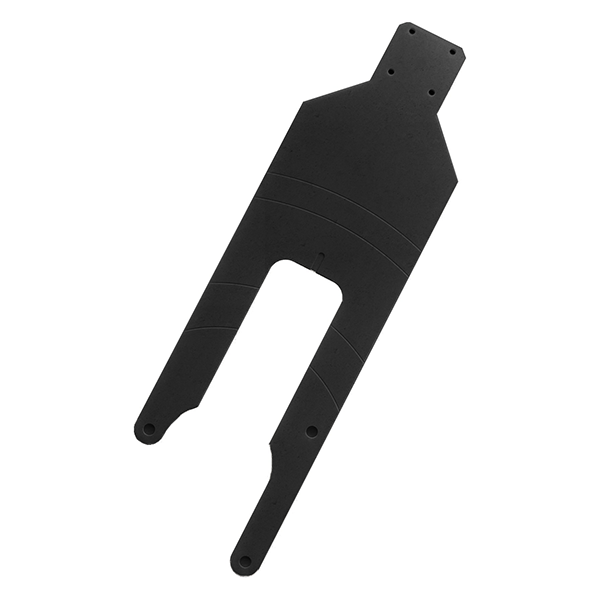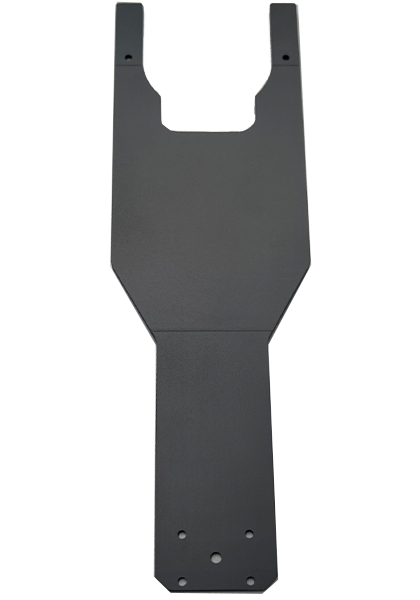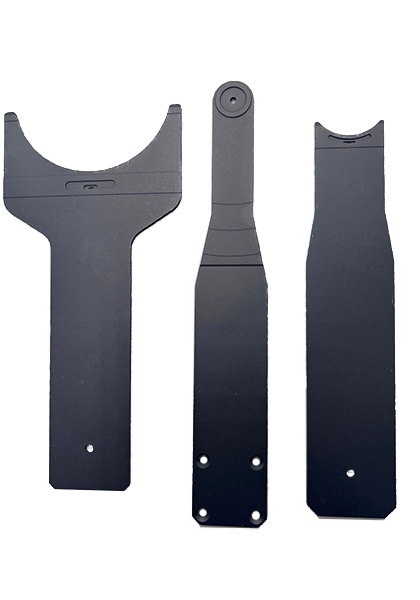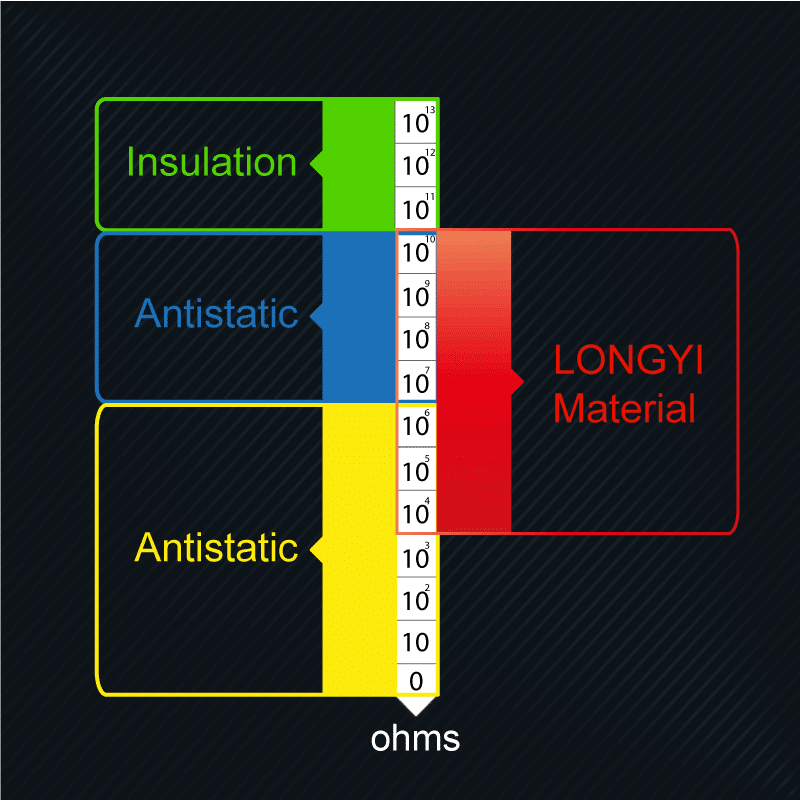Antistatic Ceramic End Effector
Antistatic Ceramic End Effector
Antistatic Ceramic End Effector can also be called ceramic finger,ceramic fork,ceramic finger,ceramic arm
Ceramic arms have many unique characteristics and advantages and are mainly used in semiconductor processing and other fields. Ceramic materials have a high degree of corrosion resistance, insulation and high temperature stability, which makes ceramic arms an ideal choice for grabbing and clamping semiconductor parts. In addition, ceramic materials are also acid- and alkali-resistant and will not contaminate products in contact with them, making them suitable for processes that require high product purity.
The application of alumina ceramic arms in semiconductor processes is even more prominent. Its advantages are high strength, high hardness, excellent wear resistance and chemical stability. This makes alumina ceramic arms widely used in the semiconductor industry, but also suitable for other demanding industrial applications. In addition, alumina ceramics have excellent insulation and thermal conductivity properties, which can effectively protect electronic components and improve the stability of equipment operation.
What properties of ceramic arms make them stand out in applications?
Ceramic arms are widely used in various industries and have properties that make them stand out in their applications. The advantages of ceramic arms are mainly reflected in their characteristics:
High Hardness: Ceramic arms usually have high hardness, which allows them to maintain stability in high-pressure environments and effectively perform precision operations.
Thermal shock resistance: The ceramic arm has good thermal shock resistance and can maintain stability in environments with rapid temperature changes and avoid deformation or damage caused by temperature changes.
Acid and alkali resistance: The ceramic arm has high acid and alkali resistance and can work stably for a long time in corrosive environments, extending its service life.
High temperature resistance: The ceramic arm has excellent high temperature resistance and can maintain stability in high temperature environments for a long time, and is suitable for various heat treatments and high temperature operations.
Low thermal expansion coefficient: The ceramic arm has a low thermal expansion coefficient, which means less deformation of the mechanical structure when the temperature changes, helping to maintain stable operation.
These properties make ceramic arms ideal for use in semiconductor manufacturing, automation equipment, medical devices, and more. Ceramic arms have the characteristics of high precision, wear resistance, and corrosion resistance, and can meet the needs of different industries for precision operations and long-term stable operation.
Ceramic arms have unique advantages and wide applications in various fields. The main materials of ceramic arms include silicon carbide ceramics and other ceramic materials. These materials have wear resistance, high temperature resistance, anti-static and other properties, making ceramic arms perform well in different fields. The following are the advantages and applications of ceramic arms:
Wear-resistant properties: Silicon carbide ceramics and other materials have excellent wear-resistant properties and are suitable for use in high-wear environments, such as semiconductor manufacturing, mechanical processing and other fields.
High-temperature resistance: Ceramic materials can withstand high-temperature environments and are therefore widely used in fields that require high-temperature operations, such as molten metal processing and glass manufacturing.
Anti-static properties: The ceramic arm has an anti-static function, which can prevent static electricity from interfering with workpieces and processes. It is especially suitable for fields with strict electrostatic requirements such as semiconductor manufacturing.
Widely used: Ceramic arms are mainly used in various industrial fields such as semiconductor manufacturing, wafer handling, and mechanical processing. In the semiconductor industry, ceramic arms are widely used in key links such as wafer transportation to improve production efficiency and quality.
Antistatic Ceramic Arm (more)



Antistatic ceramic arms play an important role in the semiconductor industry, and their main applications include semiconductor wafer transfer equipment, automation equipment, optoelectronics and solar plants. These arms have anti-static properties, require no additional coating, and comply with relevant ESD regulations to ensure the reliability and stability of equipment operation. In addition, anti-static ceramic arms are also widely used in precision machinery, military industry, medical and scientific research fields. These fields have increasingly higher requirements for the reliability and performance of equipment.
From the perspective of equipment application, anti-static ceramic arms are mainly used in semiconductor manufacturing equipment, automation equipment, and other applications that require high-precision positioning and electrostatic protection. These arms play a key role in production efficiency and product quality, providing important support for manufacturing processes in the semiconductor industry and other fields.
In the semiconductor manufacturing process, anti-static ceramic arms are mainly used for automated carrying and handling. They have anti-static properties and can avoid static electricity from interfering with the manufacturing process and ensure the quality and stability of semiconductor components. These arms can be used to carry and transport precision components in the semiconductor manufacturing process, improving production efficiency and quality consistency.
Features of the antistatic ceramic arm include volume resistance between 107 ~10 ohms, non-surface ESD coating, flatness accuracy of 0.05~0.10mm, and measured by a professional laboratory. These characteristics make antistatic ceramic arms an indispensable component in semiconductor manufacturing and other related industries, providing reliable support for the manufacturing process.

The application of alumina ceramic arms in semiconductor processes is even more prominent. Its advantages are high strength, high hardness, excellent wear resistance and chemical stability. This makes alumina ceramic arms widely used in the semiconductor industry, but also suitable for other demanding industrial applications. In addition, alumina ceramics have excellent insulation and thermal conductivity properties, which can effectively protect electronic components and improve the stability of equipment operation.
What properties of ceramic arms make them stand out in applications?
Ceramic arms are widely used in various industries and have properties that make them stand out in their applications. The advantages of ceramic arms are mainly reflected in their characteristics:
High Hardness: Ceramic arms usually have high hardness, which allows them to maintain stability in high-pressure environments and effectively perform precision operations.
Thermal shock resistance: The ceramic arm has good thermal shock resistance and can maintain stability in environments with rapid temperature changes and avoid deformation or damage caused by temperature changes.
Acid and alkali resistance: The ceramic arm has high acid and alkali resistance and can work stably for a long time in corrosive environments, extending its service life.
High temperature resistance: The ceramic arm has excellent high temperature resistance and can maintain stability in high temperature environments for a long time, and is suitable for various heat treatments and high temperature operations.
Low thermal expansion coefficient: The ceramic arm has a low thermal expansion coefficient, which means less deformation of the mechanical structure when the temperature changes, helping to maintain stable operation.
These properties make ceramic arms ideal for use in semiconductor manufacturing, automation equipment, medical devices, and more. Ceramic arms have the characteristics of high precision, wear resistance, and corrosion resistance, and can meet the needs of different industries for precision operations and long-term stable operation.
Ceramic arms have unique advantages and wide applications in various fields. The main materials of ceramic arms include silicon carbide ceramics and other ceramic materials. These materials have wear resistance, high temperature resistance, anti-static and other properties, making ceramic arms perform well in different fields. The following are the advantages and applications of ceramic arms:
Wear-resistant properties: Silicon carbide ceramics and other materials have excellent wear-resistant properties and are suitable for use in high-wear environments, such as semiconductor manufacturing, mechanical processing and other fields.
High-temperature resistance: Ceramic materials can withstand high-temperature environments and are therefore widely used in fields that require high-temperature operations, such as molten metal processing and glass manufacturing.
Anti-static properties: The ceramic arm has an anti-static function, which can prevent static electricity from interfering with workpieces and processes. It is especially suitable for fields with strict electrostatic requirements such as semiconductor manufacturing.
Widely used: Ceramic arms are mainly used in various industrial fields such as semiconductor manufacturing, wafer handling, and mechanical processing. In the semiconductor industry, ceramic arms are widely used in key links such as wafer transportation to improve production efficiency and quality.
Antistatic Ceramic Arm (more)



Antistatic ceramic arms play an important role in the semiconductor industry, and their main applications include semiconductor wafer transfer equipment, automation equipment, optoelectronics and solar plants. These arms have anti-static properties, require no additional coating, and comply with relevant ESD regulations to ensure the reliability and stability of equipment operation. In addition, anti-static ceramic arms are also widely used in precision machinery, military industry, medical and scientific research fields. These fields have increasingly higher requirements for the reliability and performance of equipment.
From the perspective of equipment application, anti-static ceramic arms are mainly used in semiconductor manufacturing equipment, automation equipment, and other applications that require high-precision positioning and electrostatic protection. These arms play a key role in production efficiency and product quality, providing important support for manufacturing processes in the semiconductor industry and other fields.
In the semiconductor manufacturing process, anti-static ceramic arms are mainly used for automated carrying and handling. They have anti-static properties and can avoid static electricity from interfering with the manufacturing process and ensure the quality and stability of semiconductor components. These arms can be used to carry and transport precision components in the semiconductor manufacturing process, improving production efficiency and quality consistency.
Features of the antistatic ceramic arm include volume resistance between 107 ~10 ohms, non-surface ESD coating, flatness accuracy of 0.05~0.10mm, and measured by a professional laboratory. These characteristics make antistatic ceramic arms an indispensable component in semiconductor manufacturing and other related industries, providing reliable support for the manufacturing process.

Other/Customized:


- About usLONGYI
- Products
- Advanced Ceramic & Fine Ceramic
- Hard and brittle materials processing
- Contact Us
- News
- Antistatic-ceramic suction cups officially enter the KLA supply system
- Chinese New Year Celebration Announcement
- Since the epidemic of COVID-19 is serious, the production staffs work separately by turns. Delivery time must be affected by process extension.
- Porous Ceramic Vacuum Chuck + Granite Base
- Company relocation notice
- Ceramic characteristics
- Ceramics Gas Tube ASSY
- Die bonder Dispensing Pin 45mil D/B
- Fittings
- Ceramic Ferrule
- Tokyo Weld / Tester / Packaging Machine / Ceramic Index table
- Ceramic Nozzle
- Ceramic Nozzle
- Ceramic Nozzle
- Die bonder Dispensing Pin D/B
- Porous ceramic vacuum chuck
- Advanced Ceramic & Fine Ceramic
|
LONGYI PRECISION TECHNOLOGY CO., LTD.
Address : No. 705, Longxing Road, Chungli District , 32091, Taoyuan, Taiwan
Tel : +886-3-466-6611 Fax : +886-3-466-7722 |
Designed by MIRACLEWeb Design
